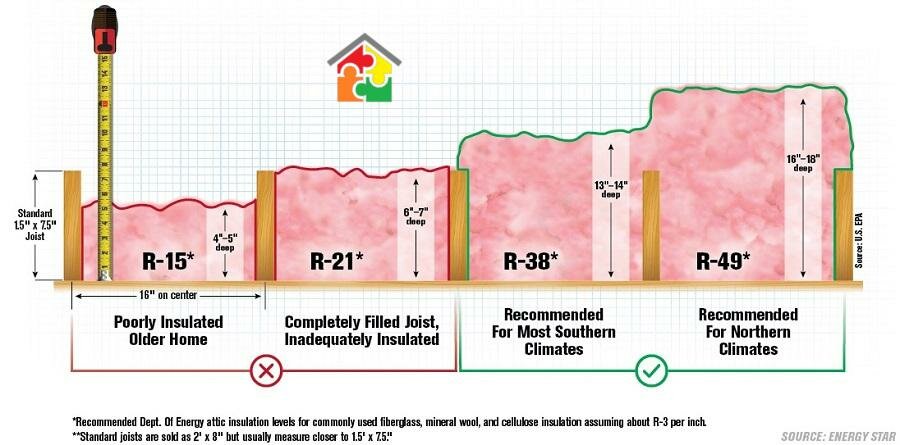
Sunny Georgia may not be the go-to destination for snow-loving travellers, but the chilly winter temperatures are cozy enough for many to want to live in the state permanently. Given Georgia’s seasonal climates, HVAC and insulation systems have become a staple at maintaining that freshness and comfort in your home, come winter or summer.
But beyond the comfort and luxury insulations give, have you ever wondered how much HVAC energy costs is saved if your house had the right amount of insulation? If you’re about to buy a home in Georgia, checking out the existing insulation (or if the house does have one in place) may help you deliberate how worth the house is for its price. Note that home insulation installation can cost between $2,000-$24,000, considering a 2,000ft2 house. So choosing a home that has insulation already may save you tons in the future.
Common Types of Insulations
The upfront costs of insulation also vary because every material differs in terms of insulating capacity, installation method, and durability. While it may be tempting to choose the cheapest option, this may also be impossible as different parts of the house can only be catered to by specific types of insulation systems. So what are the common insulation systems, and how do they keep the heat and cold at bay?
Structural Insulated Panels (SIPs)
SIPs are more common in large structures like buildings. It comes as a foam board with a high R-value and proven durability. When applied to a single-detached home, it makes the house quieter and more airtight due to its thickness. SIPs can give you energy savings between 12%-14% in the long run and sometimes up to 60%!

Batts and Rolls
Also known as blanket insulation, batts and rolls are made up of either rock & slag, wool, cotton, fiberglass, or plastic fibers. This is the most commonly used insulation and doesn’t require an insulation specialist to be installed — you can install it yourself!
Sprayed Foam and Foam-in-Place
This type of insulation is made up of either polyurethane, phenolic, polyisocyanurate, or cementitious materials. Sprayed foam insulations are very useful for finished houses. You don’t have to take down an entire wall to add insulation; all you need to do is find/make small holes and spray/inject/pour the foam through them. These are more expensive than traditional batts and rolls but definitely have higher R-values.
Insulating Concrete Blocks (ICBs)
With ICBs, insulating materials are directly applied around the concrete blocks, in the middle of them, or incorporated into the concrete mixture. So yes, ICBs are only applicable to homes that are still under construction.
Fiber Insulations
Consisting of mainly fiberglass or mineral wool, fiber board insulations are intended for air ducts or high-temperature parts of the house. The boards are prefabricated typically by HVAC contractors and can go up to 2.5 inches thick.
Rigid Foam Insulations
This type of insulation is known for its high insulating capacity despite its thinness. Similar to sprayed foam insulation, this can be made from polystyrene, phenolic, polyurethane, and polyisocyanurate materials. If installed indoors, the board is paired with a gypsum board. However, when installed on exterior walls, it has to be paired with some weatherproofing material.

Reflective Systems
As the name suggests, this type of insulation reflects radiant heat instead of transferring heat through conduction and convection. This is commonly used in attics, gazebos, lanais, etc., and you can install one yourself. Reflective insulations can lower your cooling expenses between 5%-10% during the summer. It doesn’t, however, do much with heating during the winter — you’ll need to have a heater installed if you only have this type of insulation.
Loose-Fill and Blown-In
Blow-in insulations are ideal for hard-to-reach spaces. It is usually made up of cellulose, fiberglass, or mineral wool and requires a professional with the right equipment to be installed properly. If you opt for board insulation, you’ll need blown-in insulation to fill in the gaps. The great thing about loose-fill insulation is that the materials are mostly recycled from newsprints, glass, and waste products from industrial processes.
Insulating Concrete Forms (ICF)
Like ICBs, Insulating Concrete Forms are built into the walls. This means that, apart from providing insulation, it also doubles as structural support. ICFs are made up of interlocking foam boards (held together by zip ties), poured-in concrete, and rebars.

If you’re house hunting, or maybe during the inspection, don’t hesitate to ask the seller or the seller’s agent about this. If you aren’t too keen on technicalities, though, perhaps you want an assistant who can help you find a perfectly-insulated home or recommend suitable insulation solutions for the house you want to buy. You can reach out to us at HomeSold GA — we are here to help you navigate your home-buying journey and make sure you get the best deal in town.
